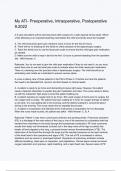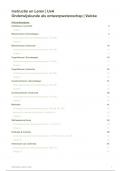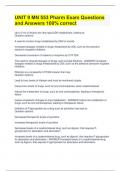My ATI- Preoperative, Intraoperative, Postoperative
9.2022
A 5-year-old patient will be returning home after surgery for a right inguinal hernia repair. Which
of the following is an important teaching need before the child and family leave the hospital?
A. The child should be given pain medicine every 4 hours for the first 24 hours.
B. There will be no dressing for the family to check because of the laparoscopic surgery.
C. Teach the family how to use the facial pain scale to ensure that the child gets pain medication
as needed.
D. Make sure the child is kept in bed for the first 12 hours to prevent bleeding from the operative
site - ANS-Answer: C
Rationale: You do not want to give the child pain medication if they do not need it, so you must
teach them how to use the facial pain scale to indicate when the child needs pain medication.
There is a dressing over the puncture sites in laparoscopic surgery. The child should be as
ambulatory and mobile as is tolerated to prevent venous stasis.
A nurse is taking care of three patients in the PACU Phase II. Prioritize and rank the patients
that need to be attended first, second, and third based on clinical needs:
A. A patient is ready to go home and demanding to leave right away, However, the patient
needs a Spanish interpreter to explain the pain medication and risks. The nurse needs to follow
up with the interpreter right away to avoid the patient walking out.
B. A patient requires an oxygen tank to go home. She used oxygen at home prior to surgery but
her oxygen tank is empty. The patient has been waiting for 2 hours for oxygen therapy to deliver
a new tank. It is now getting late in the evening, and the elderly husband is concerned about
driving in the evening. The nurse needs time to expedite the process.
C. A patient is cooperative and followed all the instructions in preparation for her discharge.
When the nurse made rounds, the patient was talkin - ANS-Answer: C, B, A
Rationale: Patient C may have a pulmonary embolus and pending stroke. Pulmonary embolism
(PE) is a blockage of the main artery of the lung or one of its branches by a substance that has
traveled from elsewhere in the body through the bloodstream (embolism). PE most commonly
results from deep vein thrombosis (a blood clot in the deep veins of the legs or pelvis) that
breaks off and migrates to the lung, a process termed venous thromboembolism (VTE). The
obstruction of the blood flow through the lungs and the resultant pressure on the right ventricle
of the heart lead to the symptoms and signs of PE. The risk of PE is increased in various
situations such as cancer or prolonged bedrest. Symptoms of pulmonary embolism include
difficulty breathing, chest pain on inspiration, and palpitations. Clinical signs include low blood
oxygen saturation and cyanosis, rapid breathing, and a rapid heart rate. Severe cases of PE
,can lead to collapse, abnormally low blood pressure, and sudden death. Patient B: Safety of the
elderly patient and spouse needs to be considered. In accordance with the policy, ordering an
oxygen tank may need coordination inside and outside the hospital and may take a longer time.
Patient A: Following up with the resource interpreter can be delegated to another nurse and if
needed to the charge nurse.
A patient tells you as you prepare to start his IV line for surgery that he has hard veins to find
and that people always miss his veins. The best response by the nurse is which of the
following?
A. "Do not worry. I am very good at this and very rarely miss."
B. "I sense that you are worried about being stuck repeatedly for an IV. I will ask someone to
help me if I miss."
C. "I can ask someone else to start your IV if you wish."
D. "I am going to ask your wife to hold your hand while I start this IV so you will not worry so
much." - ANS-Answer: B
Rationale: We should choose the answer that will help the patient feel comfortable with your
abilities to complete this task, but also know that you are able to ask for help as opposed to
keep trying. Having the wife hold his hand sounds demeaning and not so helpful. Asking if they
wish to have someone else start the IV will decrease their comfort level in your abilities. You
never want to boast too much about your abilities and not be able to complete the task.
An example of an acceptable time-out is:
A. Name, medical history, and procedure
B. Name, birthday, and procedure including site
C. Birthday, Social Security number, and surgeon's name
D. Allergies, medical history, and procedure site - ANS-Answer: B
Rationale: The name, birthdate, and the procedure, including the site are the best response.
Allergies, medical history, and Social Security number are important but not part of the time out.
Because of Maria's smoking history, the nurse understands she is at great risk for which of the
following? (Select all that apply.)
A. Increased postoperative pain
B. Difficulty with anesthesia
C. Respiratory depression during the procedure
D. Increased healing time after the procedure
E. Deep vein thrombosis after the procedure. - ANS-Answer: C, D, and E
Rationale: Smoking puts patients at risk for respiratory depression, DVT, and increased healing
time. Alcohol may pose problems with anesthesia and increased pain.
, Before administering pain medication to Mr. Wells, the nurse's assessments include which of the
following? (Select all that apply.)
A. Sedation level
B. Self-report of pain
C. Vital signs
D. Bowel sounds
E. Urine output - ANS-Answer: A, B, and C
Rationale: The nurse must assess pain level, sedation level, and vital signs in order to safely
administer pain medications and avoid oversedation. Bowel sounds and urine output are
important parameters to assess but not necessary before pain medication.
CASE STUDY - ANS-Case Study: Episode 1
Follow this patient throughout the chapter.
Your assigned OR patient is Ms. Doe, a 71-year-old widow who has a history of chronic
bronchitis and eczema and no known drug or food allergies. She was brought to the emergency
department (ED) by ambulance after complaining of severe abdominal pains for 2 days. She
states that she has had bouts of diarrhea and vomiting for the last 2 hours, with increasing right
lower quadrant pain. She verbalized to the nurse in the ED, "I am so weak I can hardly speak."
CASE STUDY - ANS-Case Study: Episode 1
Follow this patient throughout the chapter.
Howard Wells is a 70-year-old African American man. He is widowed and lives with his
daughter, a nurse. Mr. Wells's daughter brought him to the hospital today for surgery. Mr. Wells
has colon cancer and is scheduled to have a partial colectomy today in the operating room. His
additional significant medical history includes coronary artery disease and myocardial infarction
3 years ago; he is in chronic atrial fibrillation, has obstructive sleep apnea, and type 2 diabetes.
His regular medications include metoprolol, Coumadin, and omeprazole. Mr. Wells is scheduled
to have general anesthesia and is to be admitted to the hospital for a few days after surgery. Mr.
Wells's daughter will wait in the family waiting room during the procedure. She is eager to visit
him in the post-anesthesia care unit ....
Case Study: Episode 1
Follow this patient throughout the chapter. Maria Gonzalez is admitted to your facility for
preparations for her total abdominal hysterectomy. She is 40-year-old with two children aged 4
and 6 years. She has a history of fibroid tumors and deep vein thrombosis (DVT) with her most
recent pregnancy. During your initial assessment, Maria informs you of her allergies to penicillin
and latex. She has smoked 10 cigarettes a day for the past 20 years. Vital signs are noted
below:






